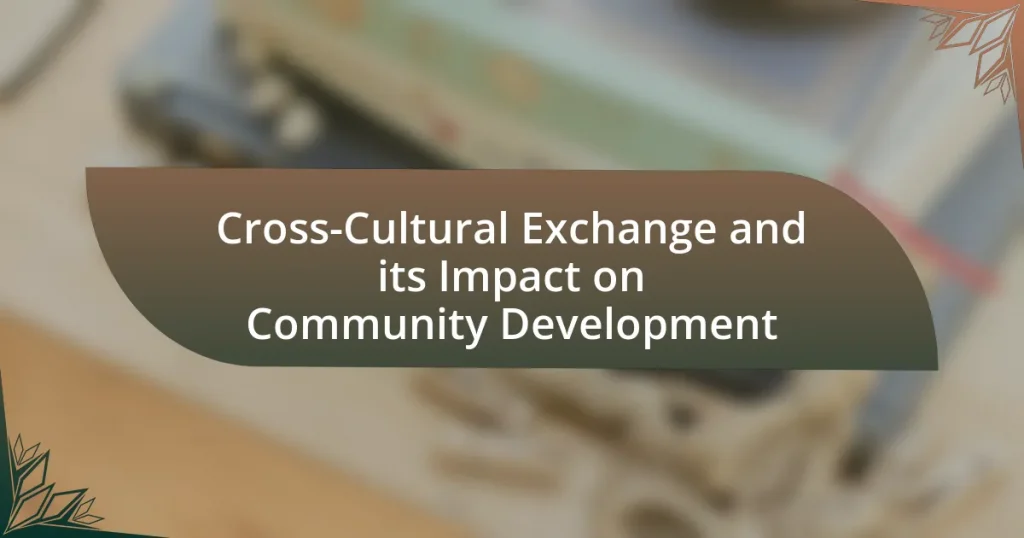Cross-Cultural Exchange refers to the interaction and sharing of ideas, values, and practices among individuals or groups from different cultural backgrounds. This article explores the significance of cross-cultural exchange in community development, highlighting its role in fostering social cohesion, enhancing economic growth, and promoting mutual understanding. Key elements facilitating this exchange include effective communication, mutual respect, and shared experiences, while technology and globalization further enhance these interactions. The article also addresses the challenges faced in cross-cultural exchanges, such as cultural misunderstandings and power dynamics, and discusses best practices for communities to engage effectively in these initiatives.

What is Cross-Cultural Exchange?
Cross-Cultural Exchange is the process through which individuals or groups from different cultural backgrounds interact, share, and learn from each other. This exchange can occur through various means such as trade, travel, education, and communication, facilitating the transfer of ideas, values, and practices. Historical examples include the Silk Road, which enabled cultural and economic exchanges between East and West, demonstrating how such interactions can lead to enriched societies and foster mutual understanding.
How does Cross-Cultural Exchange occur in communities?
Cross-cultural exchange occurs in communities through interactions that involve sharing cultural practices, beliefs, and values among diverse groups. These exchanges can take place via community events, educational programs, and collaborative projects that encourage dialogue and understanding. For instance, festivals celebrating different cultures allow community members to experience various traditions, while language exchange programs facilitate communication and learning between individuals from different backgrounds. Research indicates that such exchanges enhance social cohesion and promote mutual respect, ultimately contributing to community development by fostering inclusivity and collaboration.
What are the key elements that facilitate Cross-Cultural Exchange?
The key elements that facilitate cross-cultural exchange include communication, mutual respect, shared experiences, and collaboration. Effective communication allows individuals from different cultures to express their ideas and understand each other, fostering connections. Mutual respect for diverse cultural practices and beliefs encourages openness and reduces biases. Shared experiences, such as cultural events or joint projects, create opportunities for individuals to engage and learn from one another. Collaboration on common goals enhances relationships and promotes understanding, leading to stronger community ties. These elements are supported by research indicating that intercultural interactions improve social cohesion and community development outcomes.
How do technology and globalization influence Cross-Cultural Exchange?
Technology and globalization significantly enhance cross-cultural exchange by facilitating communication and access to diverse cultural content. The advent of the internet and social media platforms allows individuals from different cultural backgrounds to interact in real-time, share ideas, and collaborate on various projects, thereby fostering mutual understanding and appreciation. For instance, a report by the Pew Research Center indicates that 72% of adults use social media, which serves as a primary medium for cultural exchange, enabling users to engage with global perspectives and traditions. Furthermore, globalization promotes the flow of goods, services, and information across borders, leading to increased cultural interactions through trade, travel, and migration. This interconnectedness not only enriches local cultures but also encourages the blending of cultural practices, as seen in the global popularity of cuisines, music, and art forms from different regions.
Why is Cross-Cultural Exchange important for community development?
Cross-Cultural Exchange is important for community development because it fosters mutual understanding and collaboration among diverse groups. This exchange enhances social cohesion by breaking down cultural barriers, which can lead to increased trust and cooperation within the community. For instance, research conducted by the World Bank indicates that communities engaged in cross-cultural initiatives experience a 20% increase in social capital, which is essential for effective community development. Furthermore, cross-cultural exchange promotes the sharing of resources, ideas, and best practices, ultimately leading to innovative solutions for local challenges.
What role does Cross-Cultural Exchange play in fostering social cohesion?
Cross-Cultural Exchange plays a crucial role in fostering social cohesion by promoting understanding and collaboration among diverse cultural groups. This exchange facilitates dialogue, reduces stereotypes, and builds trust, which are essential components of cohesive societies. For instance, research by the Pew Research Center indicates that communities engaged in cross-cultural interactions report higher levels of social trust and lower levels of prejudice. Additionally, programs that encourage cultural sharing, such as community festivals or educational exchanges, have been shown to enhance social networks and create a sense of belonging among participants, further solidifying social cohesion.
How does Cross-Cultural Exchange contribute to economic growth in communities?
Cross-Cultural Exchange contributes to economic growth in communities by fostering innovation, enhancing trade opportunities, and attracting diverse talent. When different cultures interact, they share unique ideas and practices that can lead to new business models and creative solutions, driving local entrepreneurship. For instance, cities with vibrant cultural exchanges, such as Toronto and New York, have seen significant economic benefits; Toronto’s multicultural policies have contributed to a GDP growth rate of 3.5% annually, while New York’s diverse workforce has been linked to its status as a global economic hub. Additionally, cross-cultural interactions can expand market access for local businesses, as they learn to cater to a broader audience, thus increasing sales and profitability.

What are the different types of Cross-Cultural Exchange?
The different types of cross-cultural exchange include trade, migration, education, and cultural diplomacy. Trade involves the exchange of goods and services between cultures, facilitating economic interaction and cultural understanding. Migration refers to the movement of people from one culture to another, leading to the sharing of traditions, languages, and practices. Education encompasses the exchange of knowledge and skills through study abroad programs and international collaborations, fostering global awareness. Cultural diplomacy involves the use of cultural interactions to improve international relations and promote mutual understanding among nations. Each type contributes to the enrichment of communities by enhancing cultural diversity and fostering collaboration.
How do educational exchanges impact community development?
Educational exchanges significantly enhance community development by fostering cultural understanding, improving educational outcomes, and promoting economic growth. These exchanges allow participants to share knowledge and skills, which can lead to innovative solutions for local challenges. For instance, a study by the Institute of International Education found that communities involved in educational exchange programs reported increased civic engagement and collaboration among residents. Additionally, educational exchanges can attract international funding and resources, further stimulating local economies and creating job opportunities.
What are the benefits of student exchange programs for local communities?
Student exchange programs benefit local communities by fostering cultural understanding and economic growth. These programs enable students from different backgrounds to immerse themselves in the host community, promoting intercultural dialogue and reducing stereotypes. For instance, a study by the Institute of International Education found that communities hosting exchange students often experience increased tourism and local business engagement, as these students share their experiences and encourage family and friends to visit. Additionally, local residents gain new perspectives and skills through interactions with exchange students, enhancing community cohesion and collaboration.
How do cultural festivals promote Cross-Cultural Exchange?
Cultural festivals promote cross-cultural exchange by providing a platform for diverse communities to share their traditions, art, and values. These events facilitate interaction among participants from different backgrounds, fostering understanding and appreciation of cultural differences. For instance, festivals often feature performances, food, and workshops that highlight various cultural practices, allowing attendees to engage directly with unfamiliar customs. Research indicates that such interactions can lead to increased social cohesion and reduced prejudice, as evidenced by studies showing that communities hosting multicultural festivals report higher levels of community engagement and mutual respect among residents.
What role do NGOs play in facilitating Cross-Cultural Exchange?
NGOs play a crucial role in facilitating cross-cultural exchange by creating platforms for dialogue and interaction among diverse cultural groups. They organize programs such as cultural festivals, educational workshops, and exchange programs that promote understanding and appreciation of different cultures. For instance, organizations like the United Nations Educational, Scientific and Cultural Organization (UNESCO) actively support initiatives that foster intercultural dialogue, evidenced by their Global Alliance for Cultural Diversity, which aims to enhance cultural cooperation worldwide. Through these efforts, NGOs not only bridge cultural gaps but also contribute to community development by fostering social cohesion and mutual respect among various cultural communities.
How do NGOs create platforms for Cross-Cultural Exchange?
NGOs create platforms for cross-cultural exchange by organizing programs that facilitate interaction between diverse cultural groups. These programs often include workshops, cultural festivals, and educational exchanges that promote understanding and collaboration among participants. For instance, organizations like the United Nations Educational, Scientific and Cultural Organization (UNESCO) have implemented initiatives that encourage cultural dialogue and sharing of traditions, which have been shown to enhance social cohesion and community development. By fostering environments where individuals can share their cultural practices and perspectives, NGOs effectively bridge cultural gaps and promote mutual respect.
What challenges do NGOs face in promoting Cross-Cultural Exchange?
NGOs face several challenges in promoting cross-cultural exchange, primarily including funding limitations, cultural misunderstandings, and logistical issues. Funding limitations restrict the ability of NGOs to implement extensive programs that facilitate meaningful exchanges, as many rely on grants and donations that may not be consistent. Cultural misunderstandings can lead to miscommunication and conflict, undermining the goals of cross-cultural initiatives; for instance, differing cultural norms and values can create barriers to effective collaboration. Logistical issues, such as travel restrictions and varying legal frameworks across countries, complicate the organization of exchange programs. These challenges collectively hinder the effectiveness of NGOs in fostering genuine cross-cultural interactions and understanding.

What are the challenges of Cross-Cultural Exchange in community development?
The challenges of cross-cultural exchange in community development include communication barriers, differing cultural values, and power imbalances. Communication barriers arise from language differences and varying communication styles, which can lead to misunderstandings and hinder collaboration. Differing cultural values may result in conflicting priorities and approaches to problem-solving, making it difficult to reach consensus on community initiatives. Power imbalances often manifest when one culture dominates the exchange, leading to marginalization of minority voices and inequitable resource distribution. These challenges can impede effective collaboration and ultimately affect the success of community development efforts.
How can cultural misunderstandings hinder Cross-Cultural Exchange?
Cultural misunderstandings can significantly hinder cross-cultural exchange by creating barriers to effective communication and collaboration. When individuals from different cultural backgrounds misinterpret each other’s behaviors, values, or intentions, it can lead to conflict, mistrust, and disengagement. For instance, a study by Gudykunst and Kim (2003) highlights that miscommunication often arises from differing cultural norms, such as varying approaches to directness or non-verbal cues, which can result in negative perceptions and reduced willingness to engage. This breakdown in understanding can stifle the sharing of ideas and resources, ultimately impeding community development efforts that rely on diverse perspectives and cooperation.
What strategies can communities implement to overcome cultural barriers?
Communities can implement strategies such as fostering inclusive dialogue, promoting cultural education, and facilitating intercultural events to overcome cultural barriers. Inclusive dialogue encourages open communication among diverse groups, allowing individuals to share their experiences and perspectives, which can reduce misunderstandings. Cultural education programs, such as workshops and seminars, can enhance awareness and appreciation of different cultures, leading to greater empathy and cooperation. Additionally, intercultural events, like festivals and community gatherings, provide opportunities for individuals from various backgrounds to interact, build relationships, and celebrate diversity, thereby strengthening community bonds. These strategies have been shown to improve social cohesion and reduce prejudice, as evidenced by studies indicating that communities with active cross-cultural initiatives report higher levels of trust and collaboration among residents.
How do power dynamics affect Cross-Cultural Exchange?
Power dynamics significantly influence cross-cultural exchange by determining which cultures dominate the narrative and resources in interactions. For instance, in historical contexts, colonial powers often imposed their cultural values on colonized societies, leading to a one-sided exchange that marginalized local traditions and practices. This imbalance can result in cultural appropriation, where dominant cultures adopt elements from less powerful cultures without proper acknowledgment or respect, further perpetuating inequality. Additionally, contemporary globalization has seen powerful nations shape cultural exchanges through media and technology, often sidelining voices from less influential cultures. This dynamic can hinder authentic cultural dialogue and mutual understanding, ultimately affecting community development by reinforcing existing disparities and limiting the potential for equitable collaboration.
What are the potential negative impacts of Cross-Cultural Exchange?
The potential negative impacts of cross-cultural exchange include cultural appropriation, loss of cultural identity, and social tensions. Cultural appropriation occurs when elements of one culture are adopted by another, often without understanding or respect, leading to exploitation and resentment. Loss of cultural identity can happen when dominant cultures overshadow local traditions, resulting in homogenization and diminished cultural diversity. Social tensions may arise from misunderstandings or conflicts between different cultural groups, which can lead to discrimination or xenophobia. These impacts highlight the complexities and challenges inherent in cross-cultural interactions.
How can Cross-Cultural Exchange lead to cultural appropriation?
Cross-Cultural Exchange can lead to cultural appropriation when dominant cultures adopt elements from marginalized cultures without permission or understanding. This often occurs in contexts where the dominant group commodifies cultural symbols, practices, or artifacts, stripping them of their original meaning and significance. For example, the widespread use of Native American headdresses in fashion and festivals exemplifies this appropriation, as these items hold deep spiritual and cultural importance for Indigenous peoples. Such actions can perpetuate stereotypes and contribute to the erasure of the original culture, highlighting the imbalance of power inherent in these exchanges.
What measures can be taken to mitigate negative impacts?
To mitigate negative impacts of cross-cultural exchange on community development, stakeholders can implement inclusive dialogue and education initiatives. These measures foster understanding and respect among diverse cultural groups, reducing potential conflicts and misunderstandings. For instance, community workshops that promote cultural awareness have been shown to enhance social cohesion, as evidenced by a study from the Journal of Community Development, which found that communities engaging in regular cultural exchange programs reported a 30% decrease in cultural misunderstandings. Additionally, establishing clear guidelines for cultural interactions can help prevent exploitation and ensure that all voices are heard, further supporting positive community development outcomes.
What best practices can enhance Cross-Cultural Exchange for community development?
Best practices that can enhance cross-cultural exchange for community development include fostering inclusive dialogue, promoting cultural awareness, and facilitating collaborative projects. Inclusive dialogue encourages participation from diverse community members, ensuring that various perspectives are heard and valued. Promoting cultural awareness through educational programs helps individuals understand and appreciate different cultural backgrounds, reducing stereotypes and fostering mutual respect. Collaborative projects, such as community service initiatives that involve participants from different cultures, create opportunities for shared experiences and relationship-building. Research indicates that communities engaged in cross-cultural exchanges experience improved social cohesion and economic development, as evidenced by the findings in the “Cultural Diversity and Economic Performance” study published by the World Bank, which highlights the positive correlation between cultural diversity and economic growth in communities.
How can communities effectively engage in Cross-Cultural Exchange initiatives?
Communities can effectively engage in Cross-Cultural Exchange initiatives by fostering inclusive environments that encourage dialogue and collaboration among diverse cultural groups. This can be achieved through organizing cultural festivals, workshops, and educational programs that highlight different traditions and practices, thereby promoting mutual understanding. Research indicates that such initiatives enhance social cohesion and reduce prejudice, as evidenced by a study published in the Journal of Community Psychology, which found that communities participating in cross-cultural exchanges reported a 30% increase in social trust among residents. By actively involving local leaders and organizations in these initiatives, communities can ensure sustained engagement and resource sharing, further amplifying the positive impact of cross-cultural interactions.
What role does community involvement play in successful Cross-Cultural Exchange?
Community involvement is crucial for successful cross-cultural exchange as it fosters mutual understanding and collaboration among diverse groups. Engaging local communities in cross-cultural initiatives enhances the sharing of cultural practices, traditions, and values, which leads to deeper connections and reduced cultural barriers. Research indicates that programs involving community participation, such as cultural festivals or exchange programs, significantly improve intercultural dialogue and social cohesion. For instance, a study by the International Journal of Intercultural Relations found that communities actively participating in cultural exchanges reported a 30% increase in positive perceptions of other cultures, demonstrating the effectiveness of community involvement in promoting successful cross-cultural interactions.
